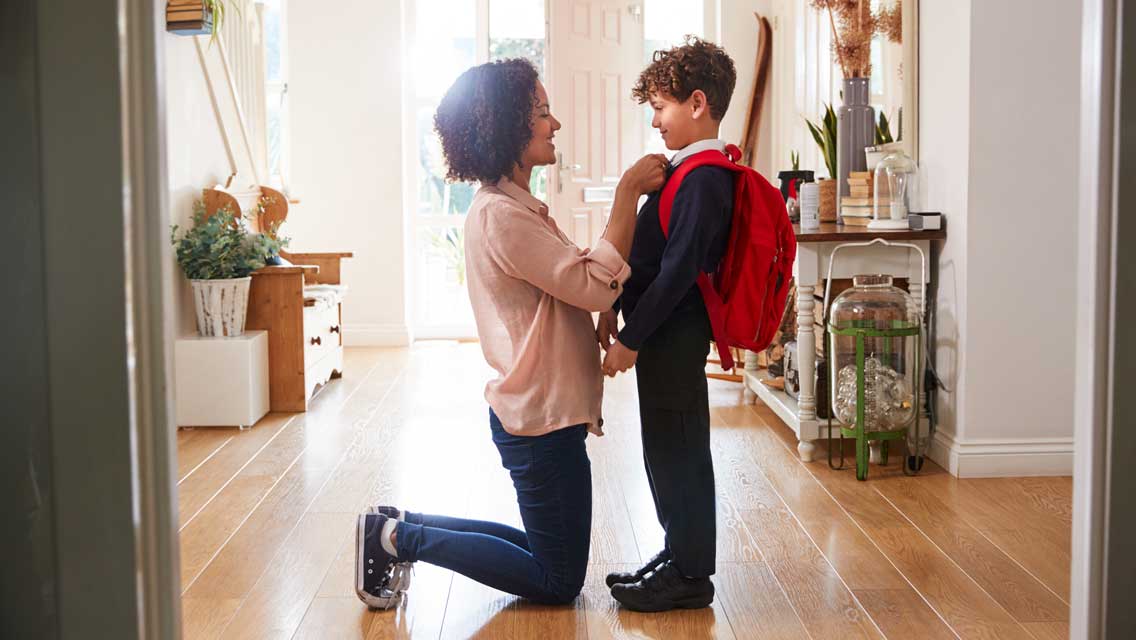Rows of people sit, eyes closed, hands relaxed, silently focusing on their breath as it fills, then empties, from their lungs. The room is quiet and serene. This may seem like a typical meditation class until you realize the location: a high school homeroom in Augusta, Ga.
Surprised? You shouldn’t be. “Stressed” is no longer just how kids across the United States describe their parents: It’s also a word they use to accurately describe themselves. Crammed schedules, performance pressures, family worries, and cultural concerns all take a toll on children. Health experts, alarmed at the scary symptoms already showing up in America’s youth, are searching for ways to help kids ease the pressure and stay healthy.
The Augusta teens were already showing signs of stress: They had elevated blood pressure, the most common physical symptom of stress. Within months, 15 minutes of daily meditation lowered their elevated blood pressure to healthy levels. Middle-schoolers in Michigan found that daily meditation eased their academic and personal stress. Meditation also boosted their self-esteem and their ability to focus.
Meditation isn’t the only way to ease the physical symptoms of stress. When families in several cities cut back on rush-rush scheduling for their children, kids reported some happy side effects: symptoms such as anxiety and stomachaches often disappeared.
Parents anywhere can rely on these same simple stress-reducing techniques to soothe their children at any age. Even better, parents can learn where stress comes from and to recognize symptoms in their children, before their health is adversely affected.
The Results of Pressure
Childhood today is vastly different than it was even a few decades ago. “Kids spend twice as much time in structured activities as they did 20 years ago, and the lack of downtime and increased performance pressure are causing more stress,” says University of Minnesota family science professor William Doherty, who coauthored Putting Family First: Successful Strategies for Reclaiming Family Life in a Hurry-Up World.
More schools are cutting back on the length of lunch-times and reducing stress-busting recesses and PE classes in order to increase time for more standardized test prepping. Our chronically high divorce rates bring on more stresses for children, who typically crave stability and reliable routines more than adults do.
Many children are stressed as well by ongoing problems with peers, academic expectations, and the stressful effects of economic disadvantage, notes child stress expert Bruce Compas, who holds a Vanderbilt University–endowed chair in psychology and pediatrics. Stress overload can cause physical and emotional symptoms, Compas notes. “Children can become anxious or depressed, have more disruptive behavior and complain of health problems such as headaches and stomachaches,” he says.
The worst effects of stress may have serious health and behavioral consequences as children grow into young adults. For example, studies with children show that chronically high levels of the main stress hormone, cortisol, is linked to increased heart rate in kids. The hormone can also contribute to a weakened immune system, and because high levels of cortisol affect metabolic hormones, stress can also increase the risk of obesity.
Repeated exposure to cortisol also causes long-term changes in children’s brains, particularly the area of the brain that processes emotional and logical responses, according to research by Megan Gunnar of the Institute of Child Development at the University of Minnesota and others.
Of course, not all stress is bad, and not all stress causes physical symptoms. For example, the act of learning new skills is a kind of stress, but when children persevere they are rewarded with a feeling of competence. How individual children cope with stress makes a difference, too. “If children deal with stress by denying it or wishing it away instead of finding ways to cope, they’re more likely to be affected adversely,” says Compas.
Steps to De-stress
When parents recognize the dangers of stress overload and begin brainstorming about solutions, the whole family stands to benefit. Often, the measures taken to lessen a child’s stress helps everyone else de-stress. For example, when a child quits a traveling sports team, the entire household may enjoy more relaxed weekend and evening time together, and more uninterrupted family dinner hours. As a result, parents often notice that the family feels closer.
Best of all, stress-aware parents may even boost their child’s important developmental processes. Children thrive with regular stretches of unstructured time to daydream, explore avenues of their own choosing, and even to try and fail at things they attempt. “Children need time when they are not being judged on their performance,” says Compas. “Plus, time that’s not defined by goals gives them important time to rejuvenate and recover from situations where they’re under more pressure to succeed.” The payoff may well show up in a healthier, more curious, relaxed and creative teen and adult.
Eager to de-stress your kid? Here’s how to begin.
- Brainstorm stress sources with your child. You may have already observed stress hot spots that correlate with symptoms, complaints or times when your child is simply not acting normally. Ask your child if he can identify patterns of physical or emotional upset. Assure him that everyone experiences stress of varying degrees, and provide some examples from your own life that may be familiar to him. Particularly for young children, you may need to go through a typical schedule for a day or a week, and ask your child how he feels about each step or activity.
- Make choices together about changes. If an overly busy schedule seems like the source of stress, strategize with your child about which activities to cut. Help him understand that factors may include driving time, social or performance pressure, or money for uniforms and gear – much more than the actual time spent at a given activity, advises Doherty, who cofounded Putting Families First, an organization that helps families restore family time and bonds.
- Guide your child in problem-solving solutions. “Parents are a child’s No. 1 teacher in problem solving,” says Compas. “They learn so much not only from how we parents deal with problems and stress in our own lives, but also from how parents consciously help kids learn how to cope with stresses.”
Compas suggests these three tips for parents:
- WORK PATIENTLY with your child to get him to evaluate and acknowledge stressed-out emotions, behaviors and stress sources.
- ASSIST YOUR CHILD in coming up with ways to change or eliminate those sources of stress that can be changed.
- HELP HIM LEARN TO ACCEPT THINGS that can’t be changed, either by recasting them in a more positive, less-pressure-filled light, or by adopting relaxation skills and activities as an antidote (see “Meditation for Any Age” below).
Teaching and modeling such skills for your children will have lasting value, say experts, and is especially valuable in a world where a bottle of pills is often presented as the only answer to stress relief.
“A pill is not a skill,” says University of Montana counseling education professor Rita Sommers-Flanagan, who coauthored Problem Child or Quirky Kid: A Commonsense Guide). Unfortunately, the use of stimulant drugs to treat children with ADD, as well as the prescription of antidepressants, now nearly equals adult use of such drugs, according to a recent report in the Archives of Pediatric and Adolescent Medicine. If you do need professional help, search out a psychologist who will instruct you and your child in stress reduction and problem solving, which can reduce the need for medications.
Try some simple stress-busting techniques. Children of all ages can benefit from relaxation techniques, such as yoga and meditation, that have proven tried-and-true for adults. “Stress reduction and relaxation techniques taught at an early age will reduce potentially deadly stress-related diseases,” says research scientist Vernon Barnes, who led the Augusta, Ga., high school meditation study. “Parents and children can easily meditate at home as well.” (See sidebar below.)
Emphasize good nutrition. An excess of sugar, refined carbs, artificial sweeteners, flavors and preservatives, combined with a lack of nutrient-dense vegetables, healthy fats and proteins, can leave your child with uneven energy, poor attention, black moods and an increased vulnerability to illness. Adjusting your child’s diet and eliminating unhealthy family eating patterns can go a long way toward moderating the impacts of stress.
De-stress kids with healthier sleep patterns. Chronic late bedtimes combined with early wake-up calls can leave kids sleep-deprived and plagued by a foggy brain, low motivation, inattention and moodiness. Their stresses increase with the fallout from poor performance and bad behavior. Start instituting firmer bedtime rules, and institute calming activities – not heart-rate-boosting TV and video games – before bedtime.
Helping your child reduce stress requires your perception and compassion. It may mean relaxing your own expectations, and it can involve a few changes in family life, but the payoff is immense. Taking positive steps to stress reduction prompts not just better well-being for your child but a heightened sense of family togetherness. Best of all, you’ll have taught your child to be stress-savvy for life.
Meditation for Any Age
It’s never too early or late to begin teaching your child to take meditative breaks. Toddlers can learn self-calming instead of getting a punitive time-out; teens will value needed breaks from stresses and responsibilities. “Children can benefit from a session as short as 10 to 15 minutes,” says Vernon Barnes, a research scientist at the Georgia Prevention Institute who researches the use of transcendental meditation in adolescents.
Try these steps to begin.
- In a comfortable, relaxed setting, ask your child to focus on her breathing by slowing it down and counting out each inhalation and exhalation. Help her feel how stress is stored in the body by having her tense a body part, then completely relax it. Guide her in a simple, tense-and-relax exercise that starts with the toes and progresses up the body, ending with the neck, head and face.
- Ask your child to become aware of things around her and of her feelings. Suggest that she simply note these sensations and thoughts. As you continue meditation sessions, you might suggest that she pay less attention to distracting and negative factors and focus more on positive sensations and emotions.
- It may take a little while for a child to realize the benefits of meditation. Ask her to keep trying it with you for a few weeks. The appeal of special time with you, combined with the rewards of a pleasant relaxation activity, will likely leave her looking forward to more sessions.
This article has been updated and originally appeared as “Underage, Under Stress” in the September 2004 issue of Experience Life.




This Post Has 0 Comments